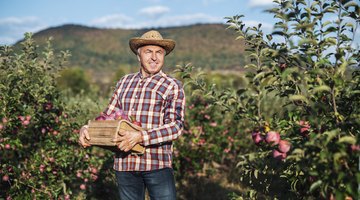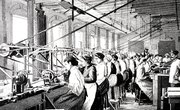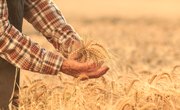Farming in Colonial times was not just a job; it was a way of life. The whole family had chores to do. With some smaller plantations, 200 to 800 acres in size, it generally took about nine adults to keep the crops growing and harvested on time. The bigger plantations had armies of workers who labored from sun up to sun down.
Significance
Farming in Colonial times was different from farming today. Whether you were farming in New England in the 1500s, the middle colonies in the 1600s, or Southern colonies in the 1700s, there was a difference in what crops were grown. Obviously, this had much to do with the climate and type of soil. Colonial farming was a serious job and meant the difference between eating well or starving, especially in the winter months.
Farming was not limited to working in the fields, where slaves often did the back-breaking work by hand. Cooking and cleaning was done by the mistress, children and house slaves, as well as mending of fences and tools used on the fields. There was a constant stream of work to be done. Middling plantation owners not only provided for their families, but also had a chance to advance in society and afford a few luxuries. The slaves did not have this same hope. The farm was all they had to show for their hard labor.
Colonial Williamsburg in Williamsburg, Virginia, is a great place to visit to see how an actual farmhouse might have operated. It gives visitors a chance to experience the sights and sounds that might have been heard in Colonial times, as well as a chance to work hands-on with the tools that farmers used in Colonial America.
Geography
New England colonies often had the roughest time in farming. The soil near the ocean was not necessarily good for farming, and the winters were harsh on the crops that were often killed before they even grew. Still, New England farmers were able to grow enough food to feed their families and neighbors. Eventually, colonists turned to fishing as their main source of earning a living, but still continued to grow the crops they could.
The farmers in the middle colonies grew the most food during Colonial times (1500s to 1800s). In fact, much of the wheat, oats, barley, corn, and rye came from these colonies. The wheat was used to make flour, which was sold to other settlement regions. Settlements often traded crops as well, and this grew to be quite a business during this time period.
The farmers in the Southern colonies grew several different types of food as well. Of course, tobacco was of utmost importance to this region; it was treated like money and was in very high demand. Tobacco was grown mostly in Virginia (the first crops were started in Jamestown) and into North Carolina. South Carolina and Georgia grew mainly indigo and rice.
Function
Farming was a family affair. Many of the parents who ran their own farms included their children at a very early age. As the children grew, the family helped their sons establish farms of their own to help give them a head start in life. When the sons married, the fathers gave their sons the gift of livestock, land and farming equipment to help them get started. When daughters got married, they also received farm animals to give to their husbands to get their own farm started.
Slaves were a big part of Colonial farming; they did most of the hard work on the fields and helped the mistress run the house in an orderly fashion. The first slaves were brought over from Africa in the mid-1500s. Each century, more and more slaves were been transported to Colonial America and made to work without pay. They did receive food, which was usually scraps and leftovers, as well as housing accommodations that were often small and unsanitary.
House slaves were treated somewhat better than field workers. Their food was of better quality, and they oftenwere given hand-me-down clothes from the family. Female slaves were encouraged to have many children to keep a steady line of slaves in the works for the plantation owners. In fact, some female slaves were promised freedom if they had 15 children. This meant freedom for the woman, but not for her children.
Potential
Besides the food, farming was different in the type of equipment that they had available to them. Colonial farmers did not have the large machinery of today's farms. Instead, they had to rely on pure manpower as well as larger animals to help sow the land and plant the crops. Oxen were used as well as horses to pull the plows, and the family members and slaves did a lot of the picking and sorting by hand. During late Colonial times (1700s to 1800s) hand sickles and scythes replaced some of the old fashioned equipment. These were used to harvest the barley, wheat and hay.
Expert Insight
Farmers during Colonial times were much more innovative in their way to farm the land and sell their goods. They started to plant nutritious English grass, such as red clover, which provided even more feed for their livestock so they would not have to use too much of the corn that they grew. Families would work together to exchange goods and labor so they could get more work done in a shorter period of time. The women helped out immensely, as it was their job to spin the yarn, sew the quilts and shuck the corn so they could make more of a business than just selling milk from the cows.
Colonial farming is a topic of great interest because it shows how the United States grew and adapted to change over time. Farming principles are much the same today as they were in the 1500s to 1800s, but great advances have been made to make farming a much more productive business.
Related Articles
Resources
Writer Bio
This article was written by the CareerTrend team, copy edited and fact checked through a multi-point auditing system, in efforts to ensure our readers only receive the best information. To submit your questions or ideas, or to simply learn more about CareerTrend, contact us [here](http://careertrend.com/about-us).










